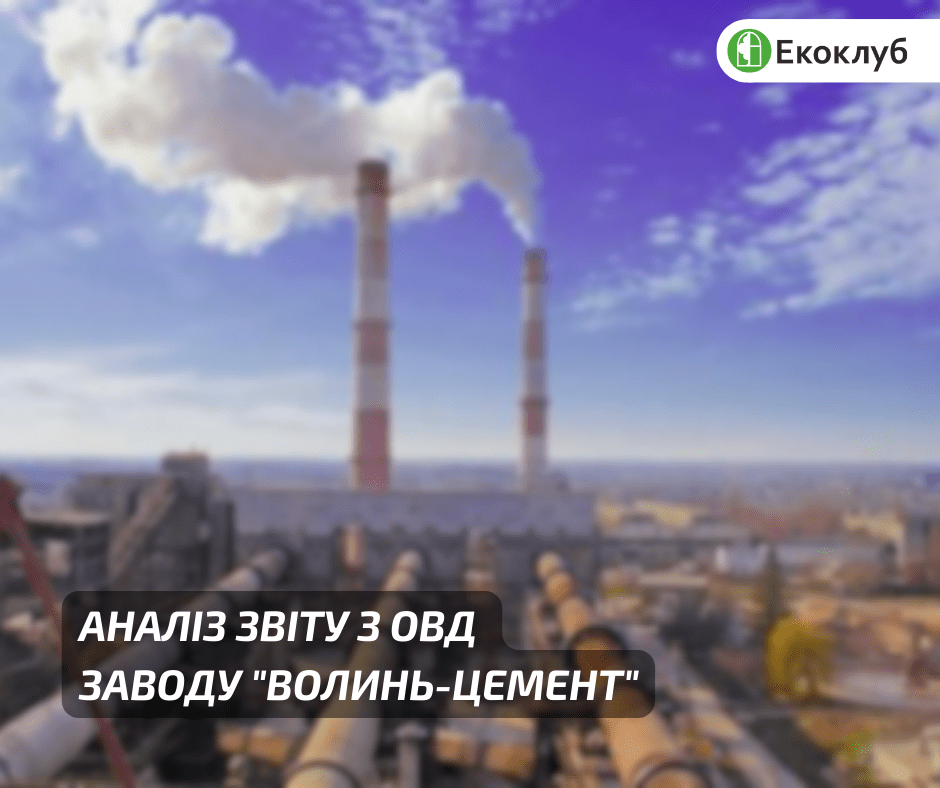VOLYN-CEMENT plant in Rivne Oblast plans to expand the list of alternative fuels it will use in production. This is stated in the company’s environmental impact assessment (EIA) report. Ecoсlub is concerned about the fuel’s volume, origin, and certification. Its combustion can negatively affect the environment and people`s health living nearby.
We believe that the plant should provide for measures to mitigate any possible negative impact. It should also ensure that any alternative fuel is safe and meets European and national environmental standards.
What is the potential danger to the environment and residents of Rivne Oblast and how can it be prevented?
What is the problem
Last year, Zdolbuniv Cement Plant announced that it was expanding the types of alternative fuels it uses. Their combustion can lead to increased emissions of pollutants into the atmosphere. However, the announcement did not specify measures to reduce the potential impact on human health and the environment.
In the list of fuels:
- SRF-, RDF-fuel,
- biomass,
- pre-treated municipal waste,
- alternative fuel made from pre-treated municipal and/or industrial waste,
- waste that is a raw material for the production of SRF and/or RDF fuel,
- residual products of the chemical industry,
- municipal waste,
- sewage sludge,
- scrap,
- alternative fuels produced from foreign-made solid waste and/or industrial waste,
- recycled municipal and/or industrial waste of foreign origin,
- municipal solid waste (MSW) and/or industrial waste of foreign origin,
- petroleum coke.
The report also does not include an assessment of the potential impact on the Zdolbuniv Ponds Emerald Network. This nature reserve is located near the plant. Nature conservationists count about 20 valuable species and habitats listed under the Convention on the Conservation of European Wildlife and natural habitats. The territory of the ponds is a habitat for waterfowl and wading birds: common and silver gulls, coots, great crested grebes, crested grebes, mallards, mute swans, etc.
Due to the Russian-Ukrainian war, access to the Unified Register of EIAs is temporarily restricted. How to obtain the EIA report for Volyn-Cement is described in this publication.
What’s wrong with the EIA report: Ecoclub’s remarks
There is no additional analysis on the carcinogenic effect of combustion products
Emissions from rotary kiln combustion are assumed to contain carcinogens. These include arsenic and its compounds, inorganic compounds, nickel metal, and hexavalent chromium. These pollutants (according to the Order of the Ministry of Health of Ukraine No. 7 of 13.01.2006) can cause cancer. However, the report’s authors (Project and Environmental Consulting LLC) did not calculate the possible impact on human health. According to the report, the emissions do not contain any pollutants that can cause cancer.
There is conflicting information about the plant’s impact on the climate. In particular, on the scale of greenhouse gas emissions.
In Section 5.5, the report authors stated that no greenhouse gases would be generated during the rotary kiln combustion. Instead, on page 914 of the report on the calculation of pollutant dispersion, greenhouse gases are present in the emissions. These include carbon dioxide and diazote oxide.
The report contains incorrect information on the types and amount of waste to be generated as a result of the activities.
On page 149, the developers have provided a list of the main types of waste generated by the operation. However, this list does not include dust collected by the gas cleaning unit at the kiln and ash generated by the waste combustion.
No information on alternative fuel certification
Without proper certification, it is impossible to know the origin and safety of the fuel.
This raises questions about the potential impact of such fuels on the environment and the health of the local residents.
There is no information on the planned volumes of alternative fuel combustion
On page 13, there is a list of alternative fuels (13 items) that are planned to be used. However, the report does not contain information on each type of alternative fuel in relation to:
- volume/weight;
- description of their composition;
- description of operations to be carried out with this waste.
Additional information: definition of alternative fuels
“Volyn-Cement plans to burn waste of various origins, sludge and even petroleum coke. These fuels do not meet the definition of “alternative” (according to the Law of Ukraine “On Alternative Fuels”):
“Alternative fuels – solid, liquid and gaseous fuels that are an alternative to the respective conventional fuels and are produced (extracted) from non-traditional sources and types of energy raw materials”.
According to Article 6 of the Law on the Procedure for Determining Fuel as an Alternative, the fuel’s classification as an alternative is confirmed by a fuel identification document (issued by an authorized executive body). Biological fuels intended for sale as commercial products are subject to mandatory certification.
How to prevent the harmful impact: Ecoclub’s suggestions
To avoid possible negative consequences, the plant should review alternative fuels for compliance with environmental standards and certification.
Public opinion can help raise awareness of the potential negative impacts of a plant by creating petitions, providing public comments or making public statements.
We demand that the Ministry of Environmental Protection and Natural Resources of Ukraine refuse to issue the Environmental Impact Assessment Conclusion for PJSC Dickerhoff Cement Ukraine regarding “Expansion of the use of alternative fuels at the Volyn-Cement rotary kiln No. 6 of the PJSC Dickerhoff Cement Ukraine branch”.
The full version of comments and suggestions to the EIA report is available here:
Comments on the EIA Report of Volyn-Cement Plant (Ukrainian only) (255 downloads )










